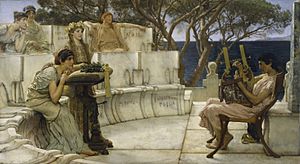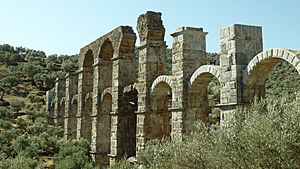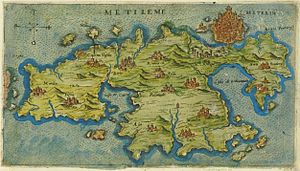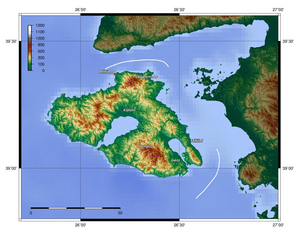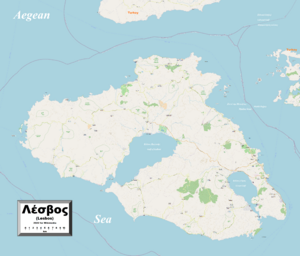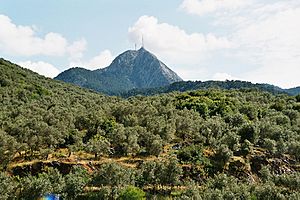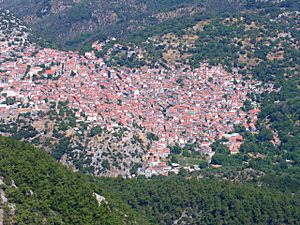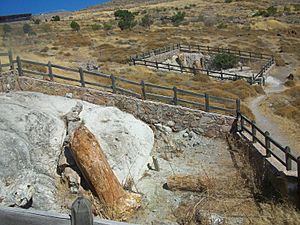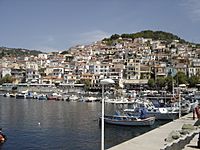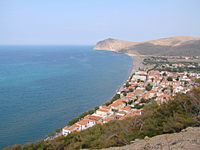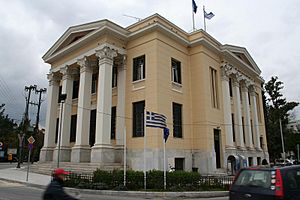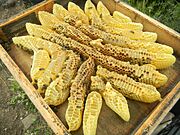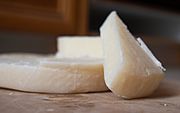Lesbos facts for kids
Quick facts for kids
Lesbos
Περιφερειακή ενότητα
Λέσβου |
|
|---|---|
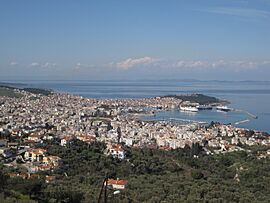
|
|
| Country | Greece |
| Administrative region | North Aegean |
| Area | |
| • Total | 1,633 km2 (631 sq mi) |
| Population | |
| • Total | 83,755 |
| • Density | 51.289/km2 (132.84/sq mi) |
| Demonym(s) | Lesbian, Lesvian |
| Time zone | UTC+2 (EET) |
| • Summer (DST) | UTC+3 (EEST) |
| Postal code |
81x xx
|
| Area code(s) | 225x0 |
Lesbos (also called Lesvos) is a beautiful Greek island located in the northeastern Aegean Sea. It covers an area of about 1,633 square kilometers (631 square miles). This makes it the third largest island in Greece and the eighth largest in the Mediterranean Sea.
Lesbos is separated from the country of Asia Minor (modern-day Turkey) by a narrow water passage called the Mytilini Strait. The island's capital and largest city is Mytilene. This city is on the southeastern coast. Sometimes, the whole island is also called Mytilene.
Lesbos is a special administrative area in Greece. Its main city, Mytilene, is also the capital of the larger North Aegean region. This region includes other islands like Chios, Ikaria, Lemnos, and Samos. In 2021, the island's population was 83,755 people. About one-third of the people live in the capital city. The rest live in smaller towns and villages. Some of the biggest towns are Plomari, Kalloni, Agiassos, Eresos, and Molyvos.
Ancient Greek writers believed Mytilene was founded around 1100 BC. A family from Thessaly called the Penthilidae ruled the city-state. Their rule ended around 590–580 BC after a popular uprising led by Pittacus of Mytilene. Records show that Greek settlers likely arrived in the late Iron Age. However, older texts from the Late Bronze Age suggest Greeks might have been there even earlier.
According to Homer's famous poem, the Iliad, Lesbos was once part of the kingdom of Priam. This kingdom was located in Asia Minor. Later, during the Middle Ages, Lesbos was controlled by the Byzantine Empire. Then, it came under the rule of the Republic of Genoa. In 1462, the Ottoman Empire conquered Lesbos. The Ottomans ruled the island until 1912, when it became part of Greece after the First Balkan War.
Contents
Island Names
The English name Lesbos comes from the Ancient Greek word Lésbos. This name also appears in old Hittite texts from the Late Bronze Age. The earliest mention of Lesbos in Greek writings is in Homer's poems. There, it is described as "well-built." The exact meaning of the name is not clear. It might have meant "forested" or "wooded."
In Modern Greek, the letter beta (β) is pronounced like a "v." This is why you sometimes see the island's name spelled Lesvos. An older name for the island was Íssa. Pliny the Elder, a Roman writer, also called the island himertḗ (meaning "desirable") and Lasía (meaning "shaggy").
In Greece, people often call Lesbos by the name of its capital, Mytilene. Some think the name Mytilene comes from an ancient word meaning "power." Others suggest it's linked to the Greek word for "mussel." The island is also sometimes called the "Island of the Poets." This is because famous poets like Alcaeus and Sappho were born there.
Island History
Early Times
People have lived on Lesbos for a very long time, at least since 3000 BC. The oldest tools found on the island might be from the late Paleolithic period. Important ancient sites include the Neolithic cave of Kagiani, which was likely a shelter for shepherds. There's also the Neolithic settlement of Chalakies and the large ancient town of Thermi (3000–1000 BC). The biggest ancient settlement is in Lisvori, dating back to 2800–1900 BC. Part of it is now under the sea.
Lesbos is mentioned in two Hittite texts from the Late Bronze Age. During this time, the island seemed to be connected to the Seha River Land. One text tells a story about purple-dyers from Lesbos who left the Sehan king.
Ancient Greek and Roman Eras
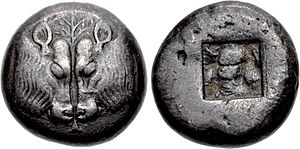
In ancient Greek stories, Lesbos was the island's special protector. Macareus of Rhodes is said to have been the first king. His many daughters supposedly gave their names to some of the island's towns today.
Homer called the island "Macaros edos," meaning the seat of Macar. Old Hittite records from the Late Bronze Age called the island Lazpa. They thought its people were important enough to "borrow their Gods" to help their king. It's believed that people from mainland Greece, especially from Thessaly, came to the island in the Late Bronze Age. They brought the Aeolic dialect of the Greek language. We can still see this written language in the poems of Sappho.
In classical times, the island had five main cities. These were Mytilene, Methymna, Antissa, Eresos, and Pyrrha. Pyrrha was destroyed by an earthquake in 231 BC. Antissa was destroyed by the Roman Republic in 168 BC.
Two of the most famous lyric poets of Ancient Greece, Sappho and Alcaeus, were from Lesbos. Pittacus was one of the Seven Sages of Greece, known for his wisdom. In classical times, Hellanicus helped develop history writing. Theophrastus, often called the father of botany (the study of plants), also lived here. He took over from Aristotle as the head of the Lyceum school. Aristotle and Epicurus lived on Lesbos for some time. It was here that Aristotle started his detailed studies of animals.
Theophanes, a historian who wrote about Pompey's military campaigns, was also from Lesbos. The ancient Greek novel Daphnis and Chloe is set on Lesbos. So, people usually think the author, Longus, was from the island.
The island became part of the Roman Republic in 79 BC. You can still see parts of its Roman and medieval history in three impressive castles. The cities of Mytilene and Methymna have been important church centers since the 5th century.
Middle Ages and Byzantine Rule
During the Middle Ages, Lesbos was part of the Byzantine Empire. In 802, the Byzantine Empress Irene was sent away to Lesbos and died there. The island was used as a base for the rebel fleet of Thomas the Slav in the early 820s. In the late 800s, it was attacked many times by the Emirate of Crete. Because of this, the people of Eresos left their town.
In 1354, the island was given to Francesco I Gattilusio from Genoa by the Byzantine emperor John V Palaiologos. The Gattilusio family ruled Lesbos for over a hundred years. They built strong defenses at the Castle of Mytilene, Molyvos (ancient Methymna), and the fort of Agios Theodoros.
Ottoman Rule
After the Fall of Constantinople in 1453, the Gattilusi family continued to rule Lesbos. But they had to pay taxes to the Ottoman Empire. In September 1462, Sultan Mehmed II conquered the island. After Lesbos was captured, some wealthy people were moved to Constantinople. Some young boys and girls were taken to serve the empire. But most of the people stayed.
Sultan Mehmed II brought Muslim settlers from other parts of the empire. He also encouraged his soldiers to settle there and marry local women. One of these soldiers was Yakub, who was the father of the famous pirate admiral Hayreddin Barbarossa. The island was named Midilli by the Ottomans, after its capital, Mytilene.
The majority of the island's people remained Greek Christians. However, there was also a significant Muslim community. These were both immigrants and people who converted to Islam. Relations between the two groups were generally good. People on Lesbos often spoke both Greek and Ottoman Turkish.
Lesbos became very successful in trade. Mytilene was considered the busiest Ottoman port in the Aegean Sea. The island exported many goods. These included olives and olive oil, wheat, grapes, wine, figs, fish, and soap. Mytilene's population grew five times during the Ottoman period. Many new mosques were built in the city. Hayreddin Barbarossa also built a school and other buildings in his hometown.
Modern Times
In 1912, the First Balkan War began. Greece, Bulgaria, Serbia, and Montenegro fought against the Ottoman Empire. The goal was to gain independence and expand Christian Balkan states. Greek naval forces landed on Lesbos on November 21, 1912. This started the Battle of Lesbos. The Greek forces quickly took Mytilene. The rest of the island was taken over by December 21, 1912.
The next year, the Ottoman Empire finally agreed to give Lesbos to Greece. This was part of the Treaty of London. After World War I and a war between Greece and Turkey, there was a population exchange. Most of the Muslims on the island left, and Lesbos became fully Greek Christian again. In 1922, many Greek refugees settled in Lesbos. These were mostly women and children who had lost their homes. A statue called the "Statue of the Asia Minor Mother" was put up in Mytilene to remember them.
Twenty years later, during World War II, Nazi Germany invaded Greece. Lesbos was occupied by Germany until September 10, 1944. Greece was then freed. The famous poet Odysseus Elytis, whose family was from Lesbos, won the Nobel Prize in Literature in 1979.
Island Tourism
Lesbos is a popular Greek island for tourists. Many visitors come during the tourism season, from April to July. In 2015, over 47,000 tourists visited Lesbos. However, the European migrant crisis that started in 2015 affected tourism. The number of tourists dropped a lot in the following years.
In 2019, the head of the Lesbos chamber of commerce said they were trying to "woo back the tourists." They wanted to remind people how beautiful Lesbos is. He asked the European Union for help with advertising. Local business owners said they had lost a lot of business because of negative media attention. However, tourist numbers started to increase again, with 63,000 visitors in 2018. The COVID-19 pandemic also hurt the island's tourism.
In 2022, the Greek government announced it would spend €2 million to help tourism in Lesbos and four other islands. It was also announced that Lesbos would welcome cruise ships again. Local officials believe the island can offer a lot to cruise tourists.
Island Geography
Lesbos is located in the eastern part of the Aegean Sea. It faces the Turkish coast to the north and east. At its narrowest point, the Mytilini Strait is only about 5.5 kilometers (3.4 miles) wide. A very long time ago, Lesbos was connected to the mainland of Asia Minor.
The island has a rough triangular shape. It has two large bays that cut deep into the land. These are the Gulf of Kalloni on the southern coast and the Gulf of Gera in the southeast.
Lesbos is a mountainous island with many forests. It has two large peaks: Mount Lepetymnos (968 meters or 3,176 feet) and Mount Olympus (967 meters or 3,173 feet). These mountains are in the northern and central parts of the island. The island was formed by volcanoes. This is why it has several hot springs and the two large gulfs.
Lesbos is very green and is sometimes called the Emerald Island. It has more types of plants than you might expect for an island its size. About 40% of the island is covered with eleven million olive trees. There are also other fruit trees. Forests of pines, chestnut trees, and some oaks cover 20% of the island. The rest is mostly scrub, grassland, or towns. The island is also a great place for bird watching.
Island Climate
Lesbos has a hot-summer Mediterranean climate. This means it has hot, dry summers and mild, wet winters. The average yearly temperature is 18°C (64°F). The average yearly rainfall is about 750 millimeters (30 inches). Lesbos gets a lot of sunshine, making it one of the sunniest islands in the Aegean Sea. Snow and very cold temperatures are rare.
| Climate data for Mytilene (1955-2010 averages) | |||||||||||||
|---|---|---|---|---|---|---|---|---|---|---|---|---|---|
| Month | Jan | Feb | Mar | Apr | May | Jun | Jul | Aug | Sep | Oct | Nov | Dec | Year |
| Record high °C (°F) | 20.2 (68.4) |
21.3 (70.3) |
28.0 (82.4) |
31.0 (87.8) |
35.0 (95.0) |
40.0 (104.0) |
39.5 (103.1) |
38.2 (100.8) |
36.2 (97.2) |
30.8 (87.4) |
27.0 (80.6) |
22.5 (72.5) |
40.0 (104.0) |
| Mean daily maximum °C (°F) | 12.2 (54.0) |
12.8 (55.0) |
15 (59) |
19.3 (66.7) |
24.3 (75.7) |
28.9 (84.0) |
31 (88) |
30.8 (87.4) |
27 (81) |
22 (72) |
17.4 (63.3) |
13.9 (57.0) |
20.9 (69.6) |
| Daily mean °C (°F) | 9.5 (49.1) |
9.9 (49.8) |
11.6 (52.9) |
15.6 (60.1) |
20.2 (68.4) |
24.7 (76.5) |
26.6 (79.9) |
26.1 (79.0) |
22.9 (73.2) |
18.5 (65.3) |
14.3 (57.7) |
11.3 (52.3) |
17.6 (63.7) |
| Mean daily minimum °C (°F) | 6.8 (44.2) |
7.0 (44.6) |
8.2 (46.8) |
11.4 (52.5) |
15.3 (59.5) |
19.6 (67.3) |
22 (72) |
21.7 (71.1) |
18.6 (65.5) |
15 (59) |
11.4 (52.5) |
8.7 (47.7) |
13.7 (56.7) |
| Record low °C (°F) | −4.4 (24.1) |
−3 (27) |
−1.2 (29.8) |
4.0 (39.2) |
8.4 (47.1) |
11.0 (51.8) |
15.8 (60.4) |
16.3 (61.3) |
10.9 (51.6) |
5.2 (41.4) |
1.4 (34.5) |
−1.4 (29.5) |
−4.4 (24.1) |
| Average precipitation mm (inches) | 111 (4.4) |
96.2 (3.79) |
70.1 (2.76) |
44.8 (1.76) |
19.8 (0.78) |
6.4 (0.25) |
2 (0.1) |
2.7 (0.11) |
12.4 (0.49) |
43.9 (1.73) |
97.1 (3.82) |
138.7 (5.46) |
670.6 (26.40) |
| Average precipitation days (≥ 1.0 mm) | 9.0 | 8.1 | 6.5 | 4.8 | 2.7 | 0.8 | 0.4 | 0.4 | 1.3 | 3.3 | 6.8 | 10.0 | 54.1 |
| Average relative humidity (%) | 71.0 | 69.8 | 57.5 | 63.9 | 62.6 | 57.3 | 56.0 | 57.4 | 59.5 | 66.1 | 71.0 | 72.0 | 64.5 |
| Source 1: Hellenic National Meteorological Service | |||||||||||||
| Source 2: NOAA | |||||||||||||
Island Geology
The entire island of Lesbos is known as "Lesvos Geopark". It's part of a special network of places around the world. This is because of its amazing geological features, educational programs, and efforts to promote geotourism.
This geopark grew from the former "Lesvos Petrified Forest Geopark." Lesbos has one of the few known petrified forests in the world. It has been declared a Protected Natural Monument. Fossilized plants have been found in many places on the western side of the island.
The fossilized forest was formed about 20–15 million years ago. This happened during a time of strong volcanic activity in the area. Volcanic rocks like andesites and rhyolites cover the central and western parts of the island. The volcanic eruptions covered the plants in the area. Over time, these plants turned into stone through a process called fossilization. These fossilized plants are the stony remains of a sub-tropical forest that once grew on the island.
Island Landmarks
Lesbos has many interesting places to visit:
- Petrified forest of Lesbos
- Catholic Church of Theotokos (which holds some relics of Saint Valentine)
- Castle of Molyvos (Mithymna)
- Castle of Mytilene
- Castle of Sigri
- Church of Panagia Agiasos
- Monastery of Agios Raphael
- Monastery of Taxiarchis
- Roman Aqueduct of Lesbos (Mória)
- The Bridge at Kremasti
- Ancient Sanctuary of Messa
- Acropolis of Ancient Pyrra
- Monastery of Ipsilou
- Monastery of Limonas
- Statue of Liberty (Mytilene)
- Ouzo Museum "The World of Ouzo" in Plomari
- Barbayannis Ouzo Museum (Plomari)
Endangered Historic Sites
In 2008, twelve historic churches on Lesbos were listed as some of the "100 Most Endangered Sites" in the world. These churches range from very old Christian buildings to ones from the 19th century. They are at risk from weather, old ways of preserving them, and too much tourism.
Here are some of the churches on the list:
- Katholikon of Moni Perivolis
- Early Christian Basilica Agios Andreas Eressos
- Church of Agios Stephanos Mantamados
- Katholikon of Moni Taxiarchon Kato Tritos
- Katholikon of Moni Damandriou Polichnitos
- Metamorphosi Soteros Church in Papiana
- Church of Agios Georgios Anemotia
- Church of Agios Nikolaos Petra
- Monastery of Ipsilou
Island Administration
Lesbos is a special administrative area within the North Aegean region of Greece. Since 2019, it has two main local governments, called municipalities. These are Mytilene and West Lesbos. Before 2019, the whole island was just one municipality called Lesbos.
The municipality of Mytilene includes these areas:
- Agiasos
- Evergetoulas
- Gera
- Loutropoli Thermis
- Mytilene
- Plomari
The municipality of West Lesbos includes these areas:
- Agia Paraskevi
- Eresos-Antissa
- Kalloni
- Mantamados
- Mithymna
- Petra
- Polichnitos
Island Economy
The economy of Lesbos mainly relies on agriculture. Growing olive oil is the most important source of money for the island. Tourism also brings a lot of income, especially in Mytilene and coastal towns like Petra, Plomari, Molyvos, and Eresos. These places are popular with visitors, partly because of the international airport.
Other ways people earn money on the island include fishing and making soap. The production of ouzo, a popular Greek drink, is also an important part of the economy.
Migrants on Lesbos
Because Lesbos is very close to Turkey, it has been greatly affected by the European migrant crisis since 2015. Many people seeking safety, especially Refugees of the Syrian Civil War, arrived on the island every day. By June 2018, thousands of refugees were staying on the island. This happened after a deal between Europe and Turkey changed their travel routes.
The Moria Refugee Camp was the largest camp on the island. It often held many more people than it was built for. In May 2020, over 17,000 refugees were living there. On September 9, 2020, a fire broke out at the Moria camp, causing thousands of migrants to leave. Firefighters worked to put out the flames.
After the Moria camp closed, a new temporary camp was quickly set up at Kara Tepe. The Greek government announced plans to build a new, more organized center in the Vastria area.
Island Culture
Local Cuisine
Here are some special foods and dishes from Lesbos:
- Chachles, a type of pasta or soup ingredient
- Kydonato, meat cooked with quinces
- Revithato, meat cooked with chickpeas
- Sardeles from Kalloni (sardines)
- Ladotyri Mytilinis, a local cheese
- Selinato, meat cooked with celery
- Sfougato, a type of omelette
- Skafoudes, stuffed eggplants
- Sougania, stuffed onions
- Ouzo, a famous Greek drink
- Platseda (a dessert)
- Finikia (a dessert)
- Amygdalota (almond cookies)
- Retseli (a sweet preserve)
Island Sports
The main football (soccer) clubs on the island are Aiolikos F.C., Kalloni F.C., and Sappho Lesvou F.C..
Island Media
Radio Stations
| Frequency | Name | Description |
|---|---|---|
| 87.5 MHz | Radio Kalloni | News, talk shows, and Greek music |
| 88.2 MHz | Love Mitilini | Easy listening music |
| 90.0 MHz | Radio Mitilini | Greek pop and rock music |
| 91.6 MHz | Rythmos Radio | Greek pop music |
| 92.3 MHz | First Programme | National news and talk from Greek state radio |
| 92.8 MHz | Aeolos FM 92,8 | Greek music (laïko, rebetiko, éntekhno styles) |
| 93.2 MHz | Astra FM 93,2 | Greek music |
| 93.3 MHz | Foni tis Ecclesias | Orthodox religious radio |
| 94.3 MHz | Second Programme | National Greek music station from Greek state radio |
| 96.5 MHz | ERT Aegean | Local news and talk from Greek state radio |
| 96.8 MHz | Minore FM 96,8 | Greek pop and dance music |
| 97.2 MHz | Third Programme | National classical music station from Greek state radio |
| 97.6 MHz | Local 9,72 Mitilini | News, talk, and music |
| 98.6 MHz | Best FM Lesvos | Greek and international music |
| 99.0 MHz | Sto Nisi 99 FM | News and talk |
| 99.4 MHz | ERT Aegean | Local news and talk from Greek state radio |
| 99.8 MHz | SKAI Aegean | News and talk |
| 101.5 MHz | Slam 101.5 | International music |
| 103.0 MHz | ERT Aegean | Local news and talk from Greek state radio |
| 104.4 MHz | ERT Aegean | Local news and talk from Greek state radio |
| 104.8 MHz | Peiraiki Ecclesia | Orthodox religious radio |
| 105.8 MHz | Peiraiki Ecclesia | Orthodox religious radio |
| 105.9 MHz | ERT Aegean / Second Programme | Local news and talk / National Greek music |
| 106.4 MHz | Third Programme | National classical music station |
| 106.9 MHz | SKAI Aegean | News and talk |
| 107.4 MHz | Peiraiki Ecclesia | Orthodox religious radio |
| 107.7 MHz | Radio Kalloni | News, talk, and Greek music |
| 107.9 MHz | ERA Sport | National sports and talk station from Greek state radio |
Television
There is a local television station called Aeolos TV that broadcasts from Mytilene.
Newspapers
The main printed newspapers on the island are Empros, Ta Nea tis Lesvou, and Dimokratis. Online newspapers include Aeolos, Stonisi, Emprosnet, Lesvosnews, Lesvospost, and Kalloninews.
Notable People from Lesbos
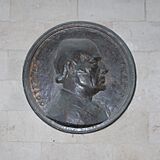
Many famous people have come from Lesbos, including:
- Lesches (8th or 7th century BC), an early poet
- Sappho (7th and 6th centuries BC), a famous poet
- Terpander (7th century BC), a poet and musician
- Alcaeus of Mytilene (7th century BC), a poet and politician
- Arion (7th century BC), a poet
- Theophrastus (370–285 BC), a philosopher and important botanist
- Theophanes of Mytilene (1st century BC), an ancient Greek historian
- Longus (2nd century AD), an ancient Greek author
- Hayreddin Barbarossa (1470s–1546), a famous Ottoman admiral
- Georgios Jakobides (1853–1932), a painter
- Theophilos Hatzimihail (c. 1870–1934), a painter
- Odysseas Elytis (1911–1996), a poet who won the Nobel Prize in Literature in 1979
- Stratis Myrivilis (1890–1969), a writer
- Elias Venezis (1904–1973), a writer
- Kostas Kenteris (born 1973), an athlete who won a gold Olympic medal in running (200 meters) in Sydney 2000
Images for kids
-
"The burning of the Ottoman frigate at Eresos by Dimitrios Papanikolis" by Konstantinos Volanakis
See also
 In Spanish: Lesbos para niños
In Spanish: Lesbos para niños



